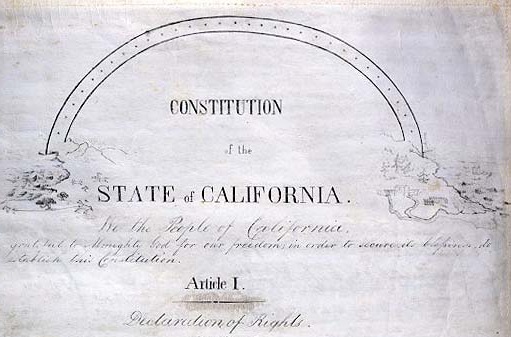
California Constitution. (Photo: www.sos.ca.gov)
What is a Constitutional Amendment?
In California, there is a legal distinction between ‘amending’ the constitution and ‘revising’ it
By Chris Micheli, December 20, 2019 7:15 am
What is a “constitutional amendment”? Although California’s Constitution provides for the amendment of this document, the constitution does not define this term. A traditional definition of a constitutional amendment is a modification to an existing constitution.
California’s Legislative Counsel defines a constitutional amendment as “a resolution proposing a change to the California Constitution. It may be presented by the Legislature or by initiative, and is adopted upon voter approval at a statewide election.”
In California, there is a legal distinction between “amending” the constitution and “revising” it. However, there is not a definition in the constitution to distinguish between the two types of modifications to the state’s constitution, but the courts have defined the difference. Article XVIII of the California Constitution sets forth amending and revising this document.
In Section 1, the Legislature is granted the ability to propose either an amendment or a revision to the constitution. Both a proposed amendments and revision requires a vote of the People. If a revision is requested by the Legislature, and the voters approved, then a constitutional convention must be convened. In Section 3, however, the people are only allowed to amend the constitution.
For constitutional amendments in California, there are two methods: those proposed by the Legislature and those proposed by the People.
By the Legislature
For constitutional amendments proposed by the Legislature, they are mentioned just once in Article IV, Section 8.5, which includes a provision for a “constitutional amendment proposed by the Legislature.” Again, the term is not defined anywhere in the state’s constitution.
Thereafter, in Article 18, Section 1, “The Legislature by rollcall vote entered in the journal, two-thirds of the membership of each house concurring, may propose an amendment or revision of the Constitution and in the same manner may amend or withdraw its proposal. Each amendment shall be so prepared and submitted that it can be voted on separately.”
As a result, the Legislature can propose amendments to the California Constitution, so long as both the Assembly and Senate vote by a 2/3 majority to place the proposal on the statewide ballot (note that the Governor does not have a formal role in the adoption of proposed amendments), but the constitutional amendments are subject to a majority vote approval of the People for adoption.
By the People
For constitutional amendments proposed by the People, the process is set forth in Article II, Section 8, which provides:
(a) The initiative is the power of the electors to propose statutes and amendments to the Constitution and to adopt or reject them.
(b) An initiative measure may be proposed by presenting to the Secretary of State a petition that sets forth the text of the proposed statute or amendment to the Constitution and is certified to have been signed by electors equal in number to 5 percent in the case of a statute, and 8 percent in the case of an amendment to the Constitution, of the votes for all candidates for Governor at the last gubernatorial election.
As a result, the state’s electorate can propose and adopt amendments to the California Constitution without approval by the Legislature or Governor. Just like with amendments proposed by the Legislature, those proposed by the People are subject to a majority vote approval of the electorate for adoption.
- Voiding or Rescinding a Declaration of Minor Emancipation - January 1, 2026
- Location of a Missing Party in Child Custody Cases - December 31, 2025
- Valuation for Eminent Domain - December 31, 2025



